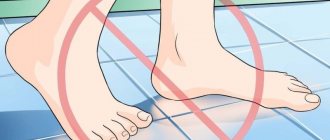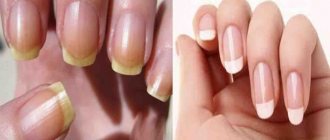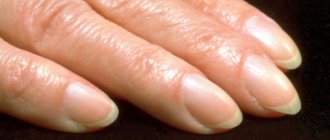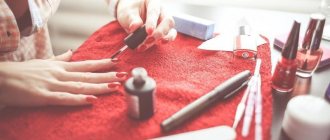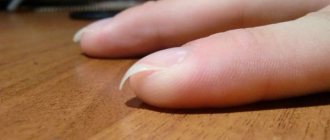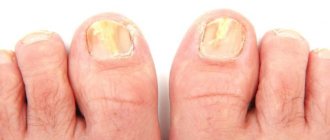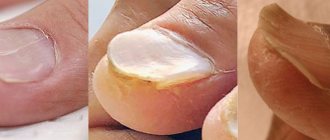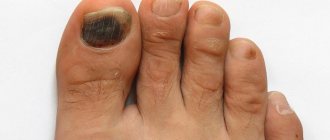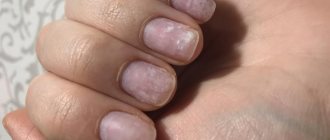Symptom of yellow nails
Yellow nails are rarely an independent disease and are usually accompanied by a number of additional manifestations:
- changes in the structure of the nail plate - thickening, thinning, roughness, fragility;
- growth slowdown;
- inflammation of the side ridges;
- signs of an allergic reaction - redness of the periungual ridges, their inflammatory swelling, small rash, itching;
- deterioration of health in the form of dizziness, migraines, loss of strength.
The intensity of these signs directly depends on the causes of yellowing.
Use of low-quality coating materials
The most common cause of yellowing is a reaction to the composition of decorative coatings. You can see yellowing after using products with the following components:
- formaldehyde and its derivatives . Formaldehyde is a carcinogenic substance that tends to accumulate in the body and over time affect the structure, color, and integrity of nails;
- toluene affects the functioning of the liver, which, in turn, affects the condition of the nail plates and skin;
- Camphor oil also affects the liver and is a powerful allergen.
Pathogenic microorganisms can develop under a dense layer of coating, especially in the presence of median detachments. Yellowing is often observed in women who systematically wear one covering for more than 4 weeks.
Lyudmila Sheveleva
Doctor, pharmacist
Ask a Question
Perhaps these are the most “harmless” reasons for yellowing nails. Refusal to use such products will allow you to restore the natural color of the plate over time. Of course, if they did not manage to provoke serious liver damage.
Health hazards of gel polish and its components
Causes of yellow nails and its treatment.
So, among the external reasons causing yellowing of nails may be:
- harmful effects on nails of chemicals (cleaning agents, detergents, etc.)
- Frequent use of nail polish without applying a base coat
- ultraviolet exposure
- using nail polish remover with acetone
- smoking tar cigarettes
External causes of yellowing of nails can be eliminated quite simply and relatively quickly. When doing your manicure, use a base coat. Apply the polish for 4-5 days, and then let your nails rest for at least a day. At this time, it is good to make whitening baths with sea salt, which also strengthens your nails. It is also good to wipe your nails with lemon juice or hydrogen peroxide. As a nail polish remover, it is better to use a liquid without acetone. Change the cleaning product or train yourself to use gloves when cleaning. As for cigarettes, it is better not to smoke at all, but if this is difficult, then try to limit contact with a cigarette to a minimum. It is also useful to drink vitamin E. Sometimes the process of getting rid of yellowness can take a long time until a completely new nail grows, which usually takes from 3 to 6 months.
Everything is much worse if the reasons that caused the yellowing of the nails are caused by internal problems in the body. It can be:
- long-term use of antibiotics
- early signs of jaundice
- liver, lung, immune system disease
- onychomycosis
- diabetes
- fungal nail infection
In this case, it is best to stop taking medications for a long time and undergo an examination at a medical institution (fluorography and a general blood test, which will reveal possible neoplasms, inflammation or changes in sugar levels).
A separate type is worth highlighting a similar disease called chromonychia or yellow nail syndrome . It is characterized by thickening of the nail plate and swelling of the fingers, and may be accompanied by other complications: pulmonary diseases, endocrine system disruption, weakened immune system, etc. Moreover, it is often congenital and is equally common in both men and women. However, there is no specific treatment for this syndrome yet. The only thing recommended is to take vitamin E.
Lack of vitamins
Vitamin deficiency is often reflected in the condition of the nails - if they turn yellow, this may indicate a deficiency:
- tocopherol - vitamin E. This vitamin regulates metabolic processes, improves the protective properties of the nail and provides sufficient hydration. To replenish the tocopherol deficiency, add fish, avocado, and spinach to your diet;
- calciferol - vitamin D. You can get it while walking in the fresh air - the vitamin is found in sunlight. Calciferol helps absorb calcium;
- ascorbic acid - vitamin C. Ascorbic acid returns healthy color to nails. Its natural sources are rose hips, black and red currants, bell peppers, parsley, white cabbage;
- biotin – vitamin B7 or H. Activates the body's protective functions, helps in the absorption of B vitamins, and also participates in the production of hemoglobin. There is a lot of biotin in beef liver, kidneys, soy, and also in many nuts.
Vitamins for nails
Internal reasons
Problems and disruptions in the functioning of the body appear on the nails gradually, affecting their structure, shape and color.
Lymphostasis
Lymphostasis is characterized by retention of lymphatic fluid and its circulation. Its symptoms increase over several years, and the nail quickly loses its ability to grow. In addition to a change in the color of the nail plate from pink to yellow, the disease is also signaled by:
- swollen lymph nodes;
- dizziness and headaches;
- itchy skin;
- swelling of the limbs.
For normal functioning of the lymphatic system, muscle work is necessary, that is, physical activity. Excellent prevention would be swimming, Nordic walking, and taking herbal immunostimulants, such as echinacea.
Techniques and features of foot massage
Oncological diseases
Tumors disrupt metabolic processes, interfering with normal blood circulation and transportation of nutrients.
With oncology, the nail plate slows down in growth and changes color, the hole and eponychium disappear. A malignant neoplasm “robs” the nails, taking away much needed calcium and phosphorus.
Onychogryphosis
Typically, onychogryphosis indicates the presence of pathologies in the body, for example, complications of diabetes.
Lyudmila Sheveleva
Doctor, pharmacist
Ask a Question
Doctors do not hesitate to make a primary diagnosis - the nail becomes like a griffin's claw. At an early stage, it thickens, loses its transparency, turns dirty yellow, becomes distorted, and even grows into the skin. If left untreated, the plate becomes twisted.
Onychodystrophy
Onychodystrophy is a disease associated with metabolic disorders. Yellowing nails are accompanied by fragility and slow growth. The color of the nail plate in the case of onychodystrophy can be from yellow to brownish-yellow. The pathology is also visually manifested by clouding, thinning, delamination, and roughness of the nail plates.
Onychodystrophy, in turn, signals the presence of another disease (congenital or acquired), for example:
- syphilis;
- measles;
- dysentery;
- typhoid fever;
- varicose veins
Psoriasis
Sometimes psoriasis develops almost imperceptibly, without affecting the skin at first. At first, nails can help determine the presence of the disease. The most commonly observed manifestations are:
- yellowing accompanied by clouding of the nail plate;
- at the side ridges, the nail plate may be partially or completely torn away from the bed;
- the appearance of hemorrhages under the nails, coloring the nail black, bluish or purple.
Lyudmila Sheveleva
Doctor, pharmacist
Ask a Question
The first discomfort occurs as the nail thins and separates from the bed. Usually these are twitching pains and unbearable itching. Please note that scratching your skin involuntarily can damage it. Staphylococcus aureus and epidermal staphylococci penetrate into microcracks, causing a severe infectious and inflammatory process.
Fungal infection
The second most common reason after the use of low-quality materials. Onychomycosis most often begins in the feet and affects the toenails. The fungus rarely develops on the hands, but can be transferred to the hands if left untreated.
What indicates a developed infection:
- whitish stripes and spots against a general yellow background;
- loss of shine and transparency;
- delamination, deformation of the nail;
- severe pain when detaching the plate from the nail bed;
- persistent unpleasant odor.
With a fungal infection, the nail not only changes color, but can also become thicker or critically thinner - it all depends on the type of fungus.
Review of antifungal drugs for nails
Lung diseases
Any abnormalities in the functioning of the lungs, including tuberculosis, significantly reduce immunity and disrupt metabolism. In this case, the body begins to intensively fight the ongoing disease, leaving “for later” care of nails, hair and other minor parts of the body.
Characteristic for pulmonary diseases:
- difficulty breathing;
- pain in the chest area;
- cough, sometimes with bloody discharge.
Nails usually turn yellow during the active development of the disease. It is often possible to diagnose pulmonary diseases before yellowing of the nail plate appears.
Why do the nails on my big toes turn yellow?
There are many reasons why a yellow toenail appears. At the same time, both men and women suffer from this problem for completely different reasons:
- Often, yellow toenails form when the patient has acute or chronic liver disease. In this case, an uncharacteristic shade of the nails first forms, and then the color of the whites of the eyes and skin becomes yellow.
- Imbalance of microflora. A lack of beneficial microorganisms in the stomach can lead to yellowness and diseases of the internal organs.
- The presence of a fungal infection. In this case, the plate on the toe looks painful, takes on an uncharacteristic color, and the tissue structure of some areas of the nail plate begins to change.
- Middle-aged and elderly people may experience the so-called yellow nail syndrome. In this case, the toenails begin to peel, thicken and change color.
- If the toenail turns yellow and becomes thicker, this may be a consequence of diabetes mellitus or other pathologies, such as psoriasis.
- The plate may become yellow and thick when the immune system is reduced or the protective or nervous system is impaired.
- Failure to comply with hygiene rules can also lead to the appearance of a yellow tint on the nail plates of the feet.
- Excessive sweating or wearing synthetic and uncomfortable shoes is also undesirable. These conditions cause symptoms characteristic of fungus - thickening of the nail and the appearance of white spots.
- With long-term use of antibiotics, you should not be surprised if the nail on your big toe turns yellow, since this factor can also cause the manifestation of the disease.
- Infectious or somatic diseases can affect the color of nails.
- 10 reasons for weight gain that are related to your health
- Which smartphones will not work with WhatsApp in 2021?
- Credit cards with a grace period - an overview of offers from Russian banks with a description of opening conditions and tariffs
Temporary yellowing
A temporary change in the color of the nail plate from pink to yellowish can be caused by:
- long-term use of medications - drug intoxication . Nails may turn yellow after courses of antibiotics: Tetracycline, Doxycycline, Ciprofloxacin. In this case, the yellowing is temporary and disappears as unexpectedly as it appears. Usually, within 2-3 weeks, when the medicine is completely eliminated from the body;
- smoking _ Smoking is an external cause, as fingers and nails become stained due to contact with tobacco smoke mixed with nicotine and tar. Yellowing disappears after thorough hand washing;
- exposure to household chemicals. Yellowing may develop due to contact with harsh chemicals used during household cleaning. This yellowing also goes away on its own within a couple of days;
- excessive consumption of strong black tea or coffee . We are, of course, not talking about 2-3 cups a day, but about exceeding this amount by 2-3 times. Black tea and coffee contain a pigment that can stain teeth and nails;
- contact with iodine-containing foods , such as green walnuts. Walnut can stain your nails yellowish to black.
Peeling nails - causes and treatment
Determining the cause of yellow nails
- carry out a visual inspection . Determine the intensity of the color and condition of the nails as a whole. As already mentioned, with yellowing, other symptoms often appear associated with changes in the structure of the nail plate;
- analyze your actions over the past few days . Perhaps you just finished a course of antibiotics or were heavy on coffee;
- if none of the causes of temporary yellowing occur in your case, make an appointment with a dermatologist.
After an external examination and history taking, the dermatologist:
- A scraping will be taken for microscopic examination to check for fungal infection. If onychomycosis is confirmed, appropriate treatment will be prescribed.
- Will write out a referral for fluorography to exclude tuberculosis;
- Conduct a general blood test for glucose, cholesterol, and syphilis;
- Prescribe lymphography - X-ray contrast study of the lymphatic system;
- Write out a referral to an oncologist for consultation;
- If the test results are negative, he will recommend donating blood to check vitamin levels.
Based on the results obtained, a diagnosis will be made and appropriate treatment will be prescribed. In the case of serious diseases, such as syphilis or tuberculosis, do not self-medicate and strictly follow the doctor’s instructions - doing it on your own can lead to worsening of the condition and complications.
Treatment
Treatment of yellowness requires a comprehensive examination. Any home methods are applicable only when the reason lies in:
- vitamin deficiency. At the same time, home and cosmetic products are used as an additional method to taking vitamin complexes;
- consequences of using low-quality coating materials;
- temporary yellowing due to taking antibiotics, smoking, excessive coffee consumption, and so on.
These listed cases are the most common causes of yellowing nails.
In other cases, treatment is required under the supervision of a dermatologist or other specialist, depending on the nature of the disease. In such situations, it is necessary to get rid of the cause, with the cure of which the yellowness will disappear.
- for fungal infections, antifungal drugs are prescribed in the form of tablets (Lamisil, Nizoral), varnishes (Batrafen, Lamisil), solutions (Exoderil);
- for diabetes, specialized medications are prescribed to normalize glucose levels;
- for syphilis - outpatient treatment with injections, droppers and tablets.
If the examination did not reveal any diseases, then try to resort to the help of cosmetic and traditional methods of treating yellowness.
Cosmetical tools
Brigitte Bottier, Repairing Polish for Yellow Nails
A transparent varnish for masking yellowness, which applies as a thin film. Due to the presence of algae extract, calcium and vitamin E, it takes care of nails, normalizes air exchange and eliminates yellowness if it is not caused by internal reasons.
Essence, Whitening polish
The brightening effect is achieved by including natural lemon extract in the composition. Can be used as a base coat for cosmetic varnish, in this case it also acts as a product that protects the nail plate from pigmentation.
Frenchi Smart Enamel Nail Whitener
The active bleaching agent is lime extract. Contains a UV filter to prevent the penetration of ultraviolet rays. Apply in 2 layers as a stand-alone product and in 1 as a base for colored varnish.
Orly, Nail Whitener
Dissolve the bleach in water and then soak in the bath for 5 minutes. Contains citric acid and tea tree oil. After the bath, it is recommended to apply a base coat or clear varnish to prolong the effect of the drug.
Remove yellowness from nails
My nail polish turned yellow. Is there any way to wash them?
Irina K., Vyatka
Manicurist Venera Gutaulina answers :
- Most likely, you used dark varnish - it most often turns your nails yellow. Many polish manufacturers produce special powders or effervescent tablets for preparing nail whitening baths. However, you can remove yellowness with home remedies.
The simplest and most accessible of them is lemon juice. They need to moisten a cotton pad and wipe their nails twice a week. You can also make hand baths with lemon juice. They are also used at least twice a week. Since lemon juice dries the skin of your hands, it is necessary to moisturize it with cream after using it. You can whiten your nails using baking soda: add 1 teaspoon of soda to 1 liter of hot water and make a hand bath twice a week.
Article on the topic
Diagnosis on the fingers: what problems in the body do peeling nails indicate?
Hydrogen peroxide also gives good nail whitening results. Moisten a cotton pad with it and wipe your nails daily. Toothpaste is also used for this. It is applied to the nails for 5-10 minutes, then washed off. If you do this for a week, the yellowness should go away. Also try sanding off the yellow deposits using a fine-abrasive nail file.
Just don’t get carried away with sanding, so as not to thin the nail plate. To prevent nail polish from staining your nails in the future, cover them with base coat before painting.
Home Remedies
To whiten nails at home, use baths, masks and lotions based on:
- lemon and citric acid;
- toothpaste;
- hydrogen peroxide;
- vinegar;
- soda;
- essential oils.
Baking soda
You can use soda in two formats - as an independent product or as one of the components of the bath.
- for a bath - add 1 tsp to 1 liter of warm water. soda and lower the brushes for 10-15 minutes. The bath has a whitening effect and also strengthens nails. Monitor the temperature of the liquid - it should not be too cold, but not scalding - from 37° to 40°C.
- To whiten with soda, take a soft brush, for example, an unnecessary toothbrush, moisten it with water and pick up a small amount of soda. Gently brush the nail plate for no longer than 30 seconds per nail. After completing the procedure, wash off the remaining soda with warm water and lubricate your hands with cream.
Baking soda can be used once a week for as long as necessary until complete whitening occurs.
Lemon lotion
- Squeeze the juice from half a lemon;
- Soak a cotton pad with the juice and rub the juice into each nail;
- Leave for 15 minutes. then add warm water.
Do not use lemon juice if you have inflamed hangnails, wounds or abrasions - lemon juice irritates the skin and causes discomfort.
Toothpaste mask
- 1 tsp. Mix whitening toothpaste with 1 tsp. baking soda and stir;
- Apply the resulting mixture to your nails and leave for 15 minutes;
- Rinse off any residue by rubbing or using a soft brush.
Express mask with peroxide
- Mix hydrogen peroxide with water in a ratio of 1 to 2 - per 1 tsp. peroxide, 2 tsp. water;
- Add 2 tsp. toothpaste and wait until it stops foaming;
- Apply the mixture for 1-2 minutes, then rinse with warm water using massaging movements.
Vinegar bath
- In 1 l. add 1 tbsp warm water. l. vinegar 70%;
- Immerse your fingertips in the bath for 10-15 minutes;
- Rinse your hands well under warm running water, wipe dry and apply cream.
Hand baths: 30 recipes for different purposes
Salt bath
- Dissolve 1 tbsp in 1 liter of water. l. sea salt;
- Add 2-3 drops of tea tree oil to the bath and soak the brushes for 10 minutes;
- Rinse off the remaining salt, then moisturize the skin with cream.
Mask with oils
- 1 tbsp. l. Mix lemon with ylang-ylang and jojoba oil. 1-2 drops of each oil will be enough;
- Apply the mixture to your nails with a cotton pad and leave for 5-7 minutes;
- There is no need to rinse off the composition - just wipe your fingertips with a dry cloth.
All these recipes only mask the problem, but do not treat the cause if it lies in a disease or other pathology. The disappearance of yellowness does not always indicate recovery, so try to maintain your health and get checked regularly.
A guide to diseases and problems with nails: diagnosis, causes and remedies for 12 diseases
Photo of yellow nails on hands:
If you notice that your nails have begun to turn yellow, then you should first of all evaluate your lifestyle, and if the reasons for this are external, then you should not worry. However, if nothing helps, immediately go to the doctor.
Tatyana, author of the blog “Manicure at home from Tanyusha!” was with you.
PS Remember about the competition taking place on my blog? The rules of the competition can be found in this article. And to always keep abreast of events in the world of manicure, subscribe to receive new articles on the day of publication on my blog.
To prevent your nails from turning yellow
- make the decorative coating with high-quality materials and remove it after 3-4 weeks. The quality of materials directly affects the condition of the nail, its color and structure, and timely removal of the material allows the nail plate to “breathe”;
- Don't neglect rubber gloves when cleaning at home. Household chemicals cause yellowing and also negatively affect the condition of the skin of the hands;
- Monitor your health and consult a doctor at the first signs of serious illness. If you find yellowing, monitor the development of the defect. If after 2 weeks the yellowness does not go away, this is a reason to contact a dermatologist or therapist;
- Take salt baths 1-2 times a month to prevent yellowing and once again strengthen the nail plate;
- consume enough vitamins and make up for their deficiency at the first manifestation of vitamin deficiency. If vitamin deficiency occurs, pay attention to the vitamins that we discussed below, but be sure to consult your doctor before use.
Solgar, Skin, hair and nails
Dietary supplement, including vitamins and minerals necessary for nails. Almost all of the components cover the body’s daily needs.
Evalar, For skin, hair and nails
Contains a complex of vitamins, including ascorbic acid, which helps even out the color of the nail plate. Also contains:
- lysine;
- cystine;
- zinc;
- copper.
Green nails and pseudomonia disease: causes, diagnosis and treatment options
Yellow nails cause discomfort and make you think about your health. Do not rush to diagnose yourself - yellowing may only be a cosmetic defect, but to determine the exact cause, it is important to consult a specialist. Have you ever encountered yellow nails? Tell us in the comments how you managed to cope with the problem and what the reason was.
5 / 5 ( 1 voice )
Why do women's toenails turn yellow?
A yellow toenail in women may appear as a result of using low-quality nail coating products (varnishes). The chemical elements contained in the composition, penetrating deep into the keratin, can cause staining of the nails. The lack of a base coat can also affect the color of the plate. When applied, any varnish gives the plate a yellowish tint. The brighter the color, the stronger the staining will be, so you should apply a nail base coat before using any bright polish.
Diagnostics
Before starting any treatment, you must consult a doctor for diagnosis. In order to determine the cause of the appearance of a yellow nail on the big toe, a dermatologist needs to examine the yellowed plate under a specialized lamp and take biomaterial (a piece of a thick plate) for microscopic examination and identification of mycoses. After this, a scraping is taken from the skin around the diseased nail and blood is drawn to detect antibodies to leprosy and syphilis.
- New rules for bank deposit insurance
- Banana ice cream
- 6 reasons for unpleasant odor in the car interior
